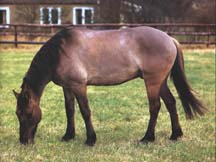Argentine Criollo
N/A
Mon, 30th June, 2025 - 3:58 pm GMT
Sponsor Ads:

Alternative Name
N/ABasic Info
The Criollo is found in a great variety of colors. In Argentina and Chile horses of tobiano coloring are excluded from registration. These colors do, however, exist in the Criollo and are recognized in Brazil, Uruguay and Paraguay. Many Argentine breeders favor the gateado (dun, translated as "cat colored"), which is said to be the color of the very toughest horses. A great majority of Criollo horses are either dun or lobuno (grullo), with dorsal stripe and zebra stripes on the legs. Curly coats are also frequently found in Criollo herds. The Criollo is a strudy, thickset horse with heavy muscling and stands between 13.3 and 15.3 hands. The neck is short and strong, the croup is sloped in Barb fashion, and the tail is carried close to the buttocks whether at work or rest. The mane and tail are thick. The head of the modern Criollo has a straight or a slightly concave profile, whearas, some twenty years ago this horse was always found to have the typical convex-shaped Barb head.
Health
N/AHabitat
N/ABehavior
The Criollo is known worldwide for its remarkable endurance and stamina. In 1925-28, A. F. Tschiffely rode from Buenos Aires, Argentina to Washington, DC, a distance of 10,000 miles, with two Criollo geldings. Both horses soundly made the trip and lived to an old age back in Argentina. Annually, The Criollo Breeders Association organizes an endurance ride or "raid" to test the stamina of the purebred Criollo horse. The ride lasts 14 days and covers 465 miles (750 km) and must be completed in less than seventy-five hours. The minimum weight the horses must carry is approximately 250 pounds of rider and tack. They are allowed no food other than that found along the trail. The endurance ride is used as a way of choosing quality-breeding stock that will pass their unusual stamina on to their offspring. Today, the Criollo is mainly a working cow horse. It is also used for pleasure riding and rodeo events as it is easy to handle, agile and quite fast. Although purebred Criollo horses are not used for polo, the cross of this horse and the English Thoroughbred has produced the ideal polo pony that possess the stamina and temperament of the Criollo and the speed of the Thoroughbred. Argentine breeders have been recognized as the best breeders of polo ponies in the world as a result of the strong Criollo horse.Origin
ArgentinaHistory
The Argentine Criollo is the result of selective breeding of the baguales, feral horses of the Pampas region of Argentina, by the gauchos of the region for a robust and useful horse. Today this horse is the national horse of Argentina and is a great source of pride for that country. Essentially the baguales of the Pampas and their ancestors, the Criollo, derive from a single source -- the bloodlines of 16th century Spanish stock introduced to the continent by the conquistadors. Many of these Spanish horses were abandoned by or escaped from these early immigrants. They formed feral herds that roamed the Pampas, the grassland area stretching north, south and west from the delta of the Rio de la Plata near Buenos Aires. The baguales also mixed with horses brought through the region as people migrated back and forth from Brazil, Uruguay and Chile. Portuguese and Dutch horses also had an impact on these feral horses as they were brought to the region from Brazil. It is the influence of these horses that distinguish the Criollo from the horses of Peru and Colombia. Many travelers and explorers reported seeing tremendous numbers of wild horses in the Pampas. Some recorded seeing herds numbering in the thousands. The native tribesmen of the region soon discovered the great value of possessing these horses. Much like the Native Americans of the North American West, the horse increased the mobility of the tribes and they soon became expert horsemen. The Spanish population also depended on these horses in settling this vast new territory. However, as in North America, as the settlers moved into the lands occupied the native tribes they began to bring change to the Pampas. Fences crops and livestock breeding began to take effect on the feral herds. In 1806 and subsequently in 1825, the British introduced the Thoroughbred to Argentina when they invaded the region. The French who brought the Percheron with them soon followed. The native Criollo horse was therefore, "improved upon" by crossing them with the Thoroughbred to make them lighter and more elegant or with the Percheron to make them larger, heavier animals suitable for draft work. With all this uncontrolled crossing, the Criollo horse of the Argentinean Pampas was threatened with extinction by the end of the nineteenth century In 1917, the Sociedad Rural de Argentina was formed in order to preserve the "creole" horse of Argentina. The group was able to locate a herd of 200 mares that had been kept by the native Indian population in the southern provinces. This herd became the foundation for the rehabilitation of the old breed. At first the horse was known as the Argentinean, then the name was changed to the Argentine Criollo. Today is also known as simply Criollo, since the horses of Brazil and Uruguay have been determined to be of the same type and ancestry.Common Foods
grassSponsor Ads:
"When shall we three meet again in thunder, lightning, or in rain? When the hurlyburly 's done, When the battle 's lost and won". Macbeth Act I, Scene I, William Shakespeare
Argentine Criollo
Coded by: BGID® | ALL RIGHTS RESERVED Copyright © 2000-2025
Disclaimer | Privacy | Report Errors / Contact | Credits
















